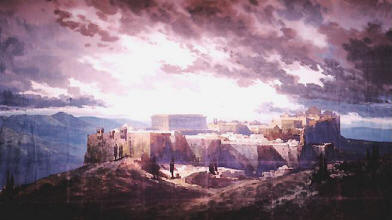 The LORD declared that the days are coming when Jerusalem is to be rebuilt from corner to corner (Jer. 31:38-39). The first thing we should recognize about the millennial Jerusalem is that she is entirely holy. To the west and south of the city in Jeremiah’s day and now lies the infamous valley of Ben-hinnom, where some Israelites worshipped Canaanite gods like Baal and Molech by sacrificing their children in fire. This practice was so depraved that it never even entered the LORD’s mind. As a result the valley was cursed and God renamed it the valley of Slaughter (Jer. 7:31; 19:2-6). The valley is referred to as Gehenna in the New Testament and was referenced by Jesus eleven times as an earthly representation of the suffering found in unquenchable Hell-fire (e.g. Matt. 10:28; Mark 9:43). In stark contrast, this once accursed and unclean valley shall become sacred to the LORD, including its very ashes (Jer. 31:40). The other major valley outside of Jerusalem, the Kidron, and to the corner of the Horse Gate toward the east will be holy to the LORD. The city and her territory will never be invaded or taken again (Jer. 31:40).
The LORD declared that the days are coming when Jerusalem is to be rebuilt from corner to corner (Jer. 31:38-39). The first thing we should recognize about the millennial Jerusalem is that she is entirely holy. To the west and south of the city in Jeremiah’s day and now lies the infamous valley of Ben-hinnom, where some Israelites worshipped Canaanite gods like Baal and Molech by sacrificing their children in fire. This practice was so depraved that it never even entered the LORD’s mind. As a result the valley was cursed and God renamed it the valley of Slaughter (Jer. 7:31; 19:2-6). The valley is referred to as Gehenna in the New Testament and was referenced by Jesus eleven times as an earthly representation of the suffering found in unquenchable Hell-fire (e.g. Matt. 10:28; Mark 9:43). In stark contrast, this once accursed and unclean valley shall become sacred to the LORD, including its very ashes (Jer. 31:40). The other major valley outside of Jerusalem, the Kidron, and to the corner of the Horse Gate toward the east will be holy to the LORD. The city and her territory will never be invaded or taken again (Jer. 31:40).
Within Jerusalem, objects as minor as the bells on horses will be inscribed with: Holy to the LORD (Zech. 14:20). This is precisely what was written upon the plate of pure gold worn by Aaron the high priest on his turban (Ex. 28:36-38). What was once intended for the high priest will now be written upon some of the most common items. Every pot in Jerusalem and Judah shall be holy to the degree that they are likened to the bowls used before the altar (Zech. 14:21). The distinction between the secular and the sacred will be no more in the great city.
The millennial Jerusalem measures ten miles by ten miles square (Ezek. 48:16, 35). She is to have twelve gates, three on each side, each named after a tribe of Israel (Ezek. 48:30-34). The primary purpose of these gates is revealed in Isaiah 60:11-12:
Your gates shall be open continually; day and night they shall not be shut, that people may bring to you the wealth of the nations, with their kings led in procession. For the nation and kingdom that will not serve you shall perish; those nations shall be utterly laid waste.
The gates must remain open so that the kings of the nations can bring their tributes to the people of Jerusalem. This is part of what it means for the nations of the earth to submit to King Jesus. Kings and tribes will be coming to lick the dust and bow before the feet of the Messiah (Ps. 72:9). Likewise, kings, queens and other descendants of those who once hated and afflicted the people of Jerusalem will come to bow at their feet, licking the dust. They will call Jerusalem: the City of the LORD, the Zion of the Holy One of Israel (Is. 49:23; 60:14). Once the Jews were forced to build cities in Egypt (Ex. 1:11). In a stunning reversal, it is foreigners who will build and maintain the very walls of Jerusalem (Is. 60:10). The service rendered by the nations is one of the methods God will use to transform the city from being hated into a joy lasting forever (Is. 60:15). Jerusalem sucking the milk of nations and the breast of kings is also how Jesus, the divine Messiah, reminds the city’s inhabitants of who He is (Is. 60:16).
A SPREADING METROPOLIS
Zechariah was given a vision that encouraged the rebuilding of Jerusalem in his day, but which finds its fulfillment in the Millennium. Zechariah 2:1-5:
And I lifted my eyes and saw, and behold, a man with a measuring line in his hand! Then I said, “Where are you going?” And he said to me, “To measure Jerusalem, to see what is its width and what is its length.” And behold, the angel who talked with me came forward, and another angel came forward to meet him and said to him, “Run, say to that young man, ‘Jerusalem shall be inhabited as villages without walls, because of the multitude of people and livestock in it. And I will be to her a wall of fire all around, declares the LORD, and I will be the glory in her midst.’”
Like with Ezekiel, Zechariah is visited by an angel with a measuring line in his hand, showing the prophet the future dimensions and glory of Jerusalem (vv. 1-2). During the restoration following the Babylonian exile, walls were built around the city so that the people would feel safe. However, most Jews were so afraid of living in Jerusalem that they cast lots, resulting in only ten percent of them moving there. Those who were actually willing to live in Jerusalem were blessed by the people (Neh. 11:1-2). Jerusalem became wide and large but there were few inhabitants and no rebuilt houses (Neh. 7:4). This is not the picture we see here where Jerusalem is to be as a city without walls due to the overflowing number of inhabitants and livestock; a place where houses, fields and vineyards shall be purchased (vv. 3-4; Jer. 32:15). While this vision encouraged the rebuilding of Jerusalem, that effort did not fulfill it. The LORD protecting Jerusalem as a wall of fire harkens back Him as the guardian pillar of fire (e.g. Ex. 13:21-22; Is. 4:5-6). When you have the Lord Messiah in your midst you do not need walls.
THE LORD IS THERE
At this time, Jerusalem will be called by a new name: The LORD is there (Ezek. 48:35). The Hebrew for this compound name, YHWH-shammah, only appears once in the entire Old Testament. It is descriptive of when much of God’s design and desire to dwell in Jerusalem forever will be fully realized (cf. Ps. 132:13-14). Remember that the city’s rebuilding is specifically for the LORD (Jer. 31:38). David is to always have a lamp before the LORD in Jerusalem, for it is the city where He has chosen to put His name forever (1 Kin. 11:36; 1 Chr. 33:4). In the Sermon on the Mount Jesus taught against making oaths by Jerusalem, for it is the city of the great king, ultimately pointing to Jesus Himself (Matt. 5:35; cf. Ps. 48:2). This is why both the Messiah and Jerusalem will be called the LORD is our righteousness (Jer. 23:6; 33:16).
Ezekiel opened his book with a vision of a storm, picturing the coming judgement upon Jerusalem (Ezek. 1:4). The prophet went on to behold the departure of the Glory of the LORD from the temple in Jerusalem (Ezek. 10:18). As sorrowful as these visions were, at the conclusion of his book Ezekiel was blessed to witness the city exalted, the LORD having returned there permanently. The name YHWH-shammah is both unique and incredibly comforting, for it describes Jerusalem when the Lord Jesus will be there.

The author of this post is in error. The 12 gates in Jerusalem will retain the names they have now. The holy city New Jerusalem contains the 12 gates named for the 12 tribes. However, Jerusalem and New Jerusalem are 2 different cities. New Jerusalem is the new redidence for Yeshua and His bride, the church. Only perfect individuals may enter into its gates. That means other than Yeshua and the saints of the church age and the resurrected Old Testament and martyred tribulation saints; all other living saints still have their sin natures intact. And the article was promising in that it had some things correct, but then it wandered away from the truth of the Bible.
Obviously Jerusalem in the Millennium and the New Jerusalem are different. This article, and the many Premillennialism articles on this site, make that quite clear. Furthermore, you can simply read Ezekiel 48:30-34 to learn the names of the gates in the millennial Jerusalem. So please explain how this article “wandered away from the truth of the Bible”?